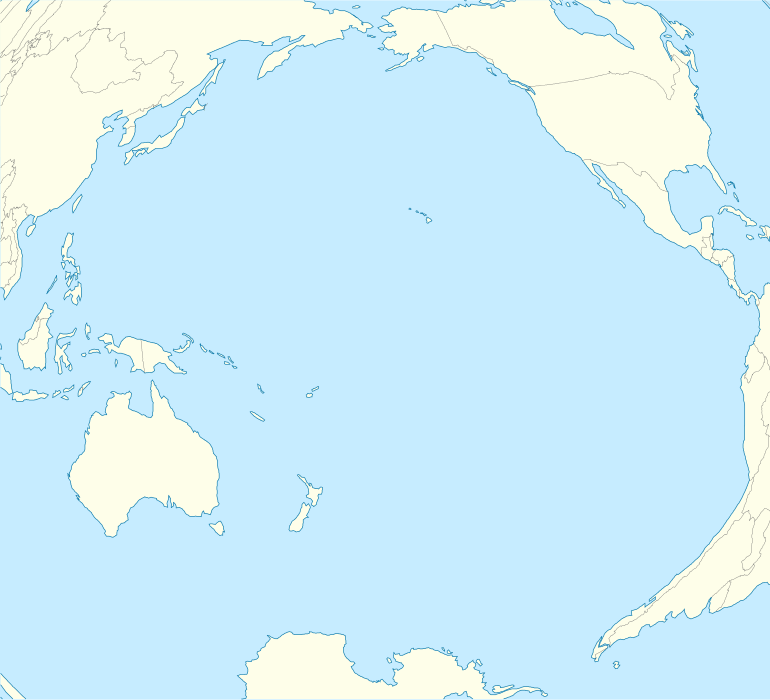Johnston Island Air Force Base
Johnston Island Air Force Base is a former United States Air Force base on the Johnston Atoll in the United States Minor Outlying Islands, in the Pacific Ocean several hundred kilometers southwest of Hawaii. After its closure, it briefly operated as Johnston Atoll Airport, until its closure in 2005.
Johnston Island Air Force Base | |||||||||||
|---|---|---|---|---|---|---|---|---|---|---|---|
 Map of the islands of Johnston Atoll, showing airstrip on Johnston Island | |||||||||||
| Summary | |||||||||||
| Airport type | Public | ||||||||||
| Location | Johnston Atoll | ||||||||||
| Elevation AMSL | |||||||||||
| Coordinates | 16°43′43″N 169°32′03″W | ||||||||||
| Map | |||||||||||
 PJON Location in the Pacific Ocean | |||||||||||
| Runways | |||||||||||
| |||||||||||
Source:[1] | |||||||||||
History
In 1935 personnel from the US Navy's Patrol Wing Two carried out some minor construction to develop the atoll for seaplane operation. They erected some buildings and a boat landing on Sand Island and blasted coral to clear a 3,600 feet (1,100 m) seaplane landing.[2] In November 1939 further work was commenced on Sand Island by civilian contractors to allow the operation of one squadron of patrol planes with tender support. Part of the lagoon was dredged and the excavated material was used to make a plane parking area connected by a 2,000 feet (610 m) causeway to Sand Island. Three seaplane landings were cleared, one 11,000 feet (3,400 m) by 1,000 feet (300 m) and two cross-landings each 7,000 feet (2,100 m) by 800 feet (240 m) and dredged to a depth of 8 feet (2.4 m). On Sand Island barracks were built for 400 men, a messhall, underground hospital, radio station, water tanks and a 100 feet (30 m) steel control tower.[2]:159
In February 1941 Johnston Atoll was designated as a Naval Defensive Sea Area and Airspace Reservation.
In September 1941 construction of an airfield on Johnston Island commenced. A 4,000 feet (1,200 m) by 500 feet (150 m) runway was built together with two 400-man barracks, two messhalls, a cold-storage building, an underground hospital, a fresh-water plant, shop buildings and fuel storage. The base was complete by 7 December 1941.[2]:159
World War II
On 15 December 1941 the atoll was shelled by a Japanese submarine outside the reef, several buildings were hit, but no personnel were injured.[2]:159
In July 1942 the civilian contractors at the atoll were replaced by 500 Seebees from the 5th and 10th Naval Construction Battalions, who expanded the fuel storage and water production at the base and built additional facilities. The 5th Battalion departed in January 1943.[2]:159 In December 1943 the 99th Naval Construction Battalion arrived at the atoll and proceeded to lengthen the runway to 6,000 feet (1,800 m) and add an additional 10 acres (4.0 ha) of parking to the seaplane base.[2]:160
US Navy and Marine units based at Johnston included:
- VB-102 operating PB4Y-1s from 28 February-22 April 1943[3]
- VB-104 operating PB4Y-1s from 11 April-14 August 1943[3]:55
- VB-142 operating PV-1s from 28 August-11 November 1943[3]:380
- VB-148 operating PV-2s from 7 June-16 August 1945[3]:384
- VP-11 operating PBY-5s from 30 April-1 July 1942[3]:402
- VP-13 operating PB2Y-3s from 1 March-19 November 1943[3]:409
- VP-23 operating PBY-5s from 7 December 1941 – 8 July 1942[3]:430
Postwar
US Navy and Marine units based at Johnston included:
References
![]()
- Airport JOHNSTON ATOLL
- Building the Navy's Bases in World War II History of the Bureau of Yards and Docks and the Civil Engineer Corps 1940–1946. US Government Printing Office. 1947. pp. 158–9. ISBN 9781460943311.

- Dictionary of American Naval Aviation Squadrons – Volume 2. Naval Historical Center. p. 139.
